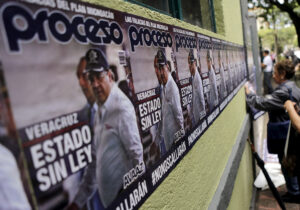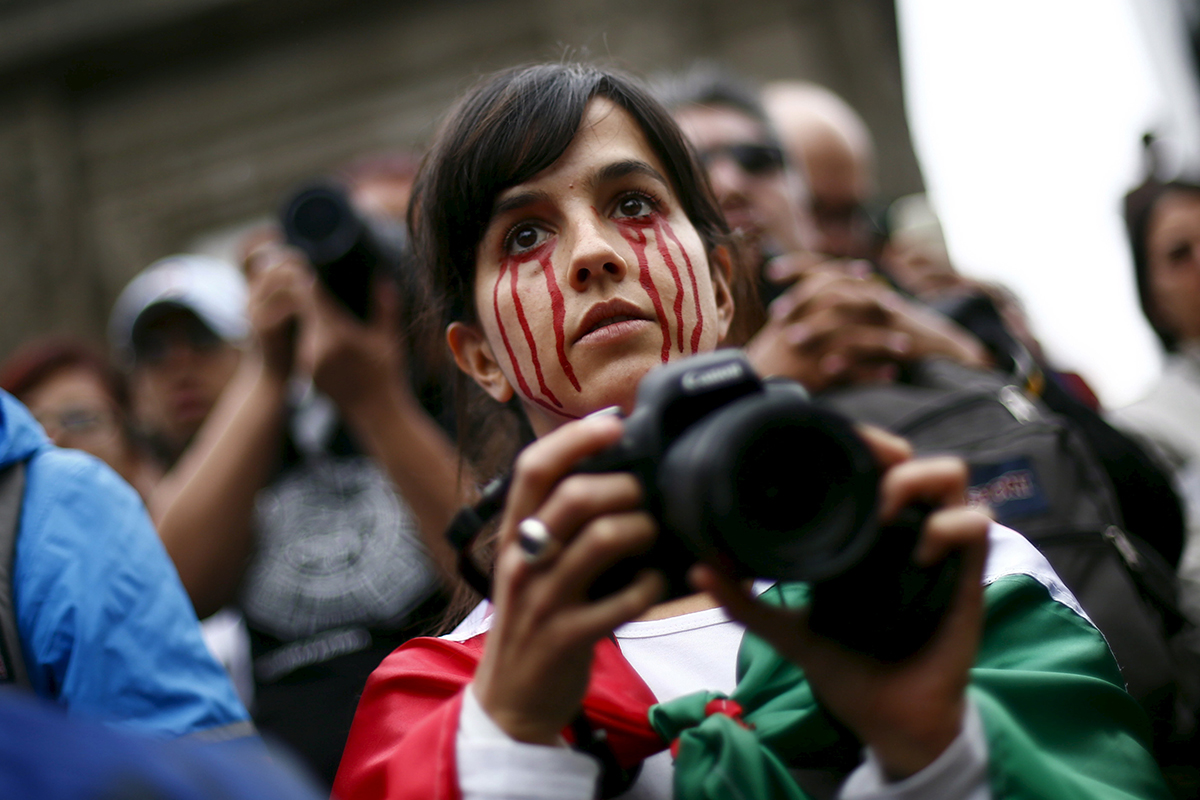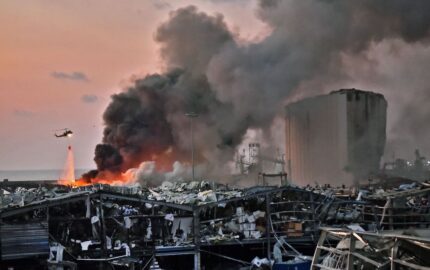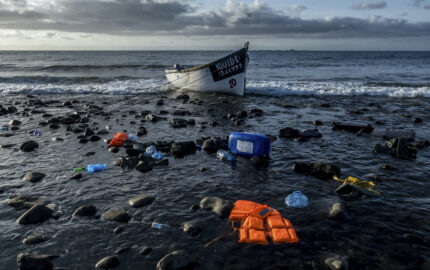Xalapa, Veracruz
In Noé Zavaleta’s bedroom, there’s a framed picture on the wall of the February 15, 2014 cover of Proceso, a leading newsmagazine in Mexico. It features a photo of Javier Duarte, the governor of Veracruz, the Mexican state on the Gulf Coast. Duarte wears a blue police cap and his belly fills a white button-down shirt. The headline: “Veracruz: Lawless State.”
For Zavaleta, it was a big deal to have a cover story in Proceso, known to be critical of the government. He lives in Xalapa, the colonial capital of Veracruz, and knows the state well. The cover meant national exposure—and exposure to great risk—for Zavaleta and Rubén Espinosa, the freelance photojournalist who shot the cover.
Duarte had long decried reporters who criticized his office, and Zavaleta’s story did just that. He pointed to corruption scandals, rising cartel-related violence, and the death of journalist Gregorio Jiménez, who was abducted after taking his kids to school and found in a hidden grave days later. Although Jiménez reported on crime in Veracruz, state officials dismissed that as a motive. Zavaleta’s article criticized the investigation and stressed this alarming fact: Since Duarte took office in December 2010, 13 journalists have been murdered in Veracruz or killed shortly after fleeing the state.

In July, Espinosa, the photographer, became number 14.
He was found dead, executed along with four women, in a Mexico City apartment. All were shot in the head with a 9-mm pistol and showed signs of torture. The other victims included Nadia Vera, a student activist in Veracruz who also left the state because of threats. “I still can’t believe it,” says a jittery Zavaleta, sitting on the edge of his bed, near the desk that’s his home office. “I haven’t stopped working since Rubén died. I’m just going, going, going. I want to believe this hasn’t happened, and that it’s all just been a nightmare and that tomorrow I’ll wake up and see Rubén.”
Journalists have faced danger in Mexico for years, with their work putting them in the crosshairs of organized criminal groups. Community leaders, lawyers, and human rights advocates who question and investigate crime in Mexico become victims, too. In addition, journalists face less visible barriers—namely, the government’s deep ties to the media. Radio and newspapers increasingly rely on the state, especially for lucrative advertising contracts. Yet some investigative reporters keep on reporting, defying the obstacles, and are part of a new wave of journalists who are more independent, digital, and collaborative.
The risks have escalated, though, especially since 2006, when President Felipe Calderón launched a military-led attack on organized crime. That effort failed, and violence skyrocketed, as did threats against journalists. The 2006 murder of Brad Will, a New York-based independent journalist killed in the southern state of Oaxaca while covering anti-government protests, is emblematic. Will inadvertently videotaped his own death, as his camera captured pro-government men firing at the protesters and in his direction. Yet those men were not convicted of the crime. Instead, Juan Manuel Martínez, a baker who lived near the crime scene, was arrested, although officials could never produce a witness putting him at the site. After 16 months in prison, Martínez was cleared of murder and released. He told me it was “easier to implicate somebody like me than the real killers.” Nine years on, Will’s murderers remain free.
The murder in July of Rubén Espinosa shattered the image of Mexico City as a safe haven
As the violence increased, in-depth reporting at mainstream papers in much of Mexico’s north vanished. In 2008, in Ciudad Juárez, across from El Paso, cartels fought for control, and Armando Rodríguez, a top crime reporter for the city’s El Diario, was shot in his driveway in front of his young daughter. I met Rodríguez shortly before he died. He was known for keeping a daily tally of the city’s homicides, something local officials didn’t track. That year, in a city of 1.3 million, the death toll topped 1,500, nearly 5 murders a day. He looked worn and said, “I feel like a war reporter, but there are no battle lines.”
In 2012, Calderón’s term ended. During his six-year administration, more than 100,000 people were killed or disappeared, according to the government’s own reports. Under current President Enrique Peña Nieto, homicide rates are moving up again after a brief decline as cartels fracture and fight for drug routes.
In all, since 2000, 88 journalists have been killed in Mexico, according to Article 19, a U.K.-based press freedom group. Crimes are very rarely solved. Investigations tend to drag on, with prosecutors overloaded and operating in an antiquated system. Sometimes murder probes simply stop cold when they might implicate government officials. “Politics can get in the way,” says Carlos Lauría, the senior Americas program coordinator for the Committee to Protect Journalists (CPJ). “You’ll see cases with strong evidence, but you won’t see results.” This year, Mexico took the eighth spot on the CPJ’s Global Impunity Index, in between Afghanistan and Pakistan. And with four journalists killed so far this year, Mexico has already doubled its 2014 death tally.
Related Article
Killing Journalists with Impunity
—Elisabeth Witchel
Espinosa’s murder also marks a turning point. It is rare for a journalist to be killed in the capital. It shattered the city’s safe haven image where, for the most part, journalists under threat could feel anonymous in a 20 million-plus metropolis. “We all felt the chill,” says Alfredo Corchado, the Mexico bureau chief for The Dallas Morning News, though he makes clear that foreign journalists do not face the same threats as their Mexican colleagues. “I have a U.S. passport and can jump on a plane at any time,” he says. Organized criminal networks do not want to test the U.S. government or risk any disruption of their businesses.
Local reporters like Espinosa face the greatest threats. His difficulties started in 2012, when a government official told him to stop covering a student protest or he would “end up like Regina,” a reference to Regina Martínez, a Proceso reporter strangled to death at her home in Xalapa that year. Officials tied her death to a robbery, but Espinosa and other journalists were convinced that her crime reporting led to her death.
In May, Espinosa placed a small plaque in Xalapa’s main plaza, outside the state government’s offices. It read: “Regina Martínez Plaza,” and was meant to pay homage and protest the investigation. A picture of the ceremony shows Espinosa, with short black hair and wearing a photographer’s vest, carefully affixing the plaque while colleagues look on. “Espinosa called for justice in Regina’s case again and again,” says Norma Trujillo, who reports from Xalapa for La Jornada, a left-leaning daily. “He was a leader, but I was afraid for him.” Soon after, Governor Duarte told journalists to “behave” and called them “rotten apples” that would soon fall.
In June, Espinosa finally left Veracruz for Mexico City. He had photographed a student protest at which men attacked demonstrators with machetes. After that, he told friends that armed individuals were outside his home. “He got really scared,” Zavaleta says.

So far, the Espinosa investigation is sticking to a worn script. It looks like a robbery, say officials. But a photograph of one of the arrested men shows his face with a fresh black eye, possible signs of a forced confession in a country where the practice is common. Televisa, the country’s dominant broadcaster, known for its pro-government stance, said toxicology reports found Espinosa tested positive for marijuana and cocaine. Many saw it as a way to publicly discredit Espinosa. “In Mexico, they kill you twice. The first time with a bullet and then by character assassination,” says Corchado. The U.N. Office of the High Commissioner for Human Rights has joined other groups calling for a new investigation. Duarte said the killings were “aberrant” and that he was confident the cases would be cleared up “as fast as possible.”
“In Mexico, they kill you twice. The first time with a bullet, and then by character assassination”
—Alfredo Corchado
Journalists do what they can to protect themselves. Newspapers omit bylines and photo credits from certain crime stories. There is self-censorship, with reporters excluding names of cartels from their articles, especially in small regional publications. Swaths of the country are simply written off as no-go zones. And for many reporters, gone are the days of pursuing an “exclusive.” Today, more journalists team up and join tight-knit WhatsApp groups to stay updated on risks and their whereabouts.
Some of these rules apply for foreign journalists, too, with some going further and tapping protocols still out of reach for most Mexican journalists. While reporting a recent story on children harvesting opium in Mexico’s poppy fields, Azam Ahmed, The New York Times Mexico bureau chief who moved from Kabul to Mexico City in July, regularly sent out his GPS coordinates to the Times’s security chief, just like he did in Afghanistan. “It’s not a war zone, but I didn’t want to be cavalier or complacent,” he says. “I want people to know where I was last.”
Mexican field producers working with foreign journalists who parachute in are also on alert to protect each other—and their sources. Ulises Escamilla, a Mexico City-based reporter who has helped produce stories for Al Jazeera, The New York Times Magazine, and the BBC, packs ski masks in his kit in case a source’s identity must be protected. “I’ll look at someone who is about to go on camera and think, ‘No, no, no, we have to protect them.’ We get to leave this town, but they’ll stay behind,” he says. “There’s a lot of paranoia, but that’s part of our defense.”
There has been some response at the federal level to the danger. Laws now federalize press crimes so that the same local authorities accused of threatening journalists don’t also lead the investigations. There is also a special federal prosecutor’s office. But ongoing skepticism about investigations mar these efforts and damage the latest one—a new law and agency to provide threatened journalists and human rights workers with official protection in the form of security cameras, panic buttons, and safe houses.
Espinosa steered clear of the program, and many others do, too. “Why would you ask the government to protect you if the threats you face are linked to the state itself?” says Sandra Rodríguez Nieto, who reported on Espinosa’s murder for the online magazine SinEmbargo. “You know what would make me feel safe? Don’t offer me a damn panic button. Solve the case of one dead journalist. Just one! That would show us that you can’t get away with murder.”
Yet some journalists have signed up, like Norma Trujillo in Xalapa. After her colleague Regina Martínez was killed in 2012, Trujillo started shoving a chair against her front door every night. “If I heard a noise, I’d jump,” she says. “That fear hasn’t left me.” She insists that the protection program “doesn’t guarantee anything,” but says she won’t deny herself any safety measure.
Meanwhile, others have given up being in Mexico altogether. Félix Márquez, a photojournalist from Veracruz who has worked with the Associated Press and Proceso, left for Chile not long after Espinosa’s murder. “I couldn’t do my work without a guarantee of safety,” he says. “It was best to stop for a while and take a break from Mexico.”
Despite the fear and violence, a strengthening group of newer publications is taking hold. They include Animal Político, SinEmbargo, Diario19, Emeequis, La Silla Rota, and Más por Más, a free paper. Many are found exclusively online, testing new ways to stay afloat by tapping foundations, angel investors, and readers’ donations. They also attract top reporters, who are breaking away from Mexico’s traditional large papers and broadcasters, restrained by their ties to the state. “There is a big part of the press that operates under the government’s shadow,” says Darío Ramírez, Mexico director of Article 19.
That shadow is growing, too. The amount Peña Nieto’s government spends on publicity has increased by 80 percent compared to previous presidents. “If you took away that spending, you’d see newspapers across the country vanish,” says Ramírez. He calls this flow of non-regulated public money into news outlets the “bone cancer” of journalism. The grip keeps a pro-government narrative intact and investigations that uncover corruption buried.

The alternative outlets are breaking that hold. At a recent editorial meeting at Animal Político, editors and reporters huddled over how to cover a massive march in Mexico City to mark one year since 43 college students disappeared in Guerrero, the Pacific Coast state. The story of the missing students rocked the country. The planned march also coincided with an Inter-American Commission on Human Rights report that pointed to numerous holes in the government’s official version of what happened. For Animal Político, the Commission’s report offered a rare chance to show their audience a side-by-side comparison of findings by an independent group of experts and the government’s.
It was a stark contrast to the coverage (and nearly identical headlines) offered by Mexico’s biggest papers, which framed the government’s conclusions as fact and discredited the independent report’s findings. Coverage of the Mexico City march was also buried. “We don’t have much money,” says Dulce Ramos, editor of Animal Político. “But to a certain point we prefer it that way, so we can do the coverage we want and keep our independence. There’s an information vacuum, and we’re trying to fill it.”
New alliances among journalists are also bringing out investigative work that might not otherwise appear. In November 2014, a reporting team led by Carmen Aristegui, one of Mexico’s most famous journalists, uncovered how Peña Nieto’s wife had bought a white, Miami-style mansion from government contractors. Instead of breaking the story on her popular radio show, Aristegui and her team published the story on her own website, Aristegui Noticias, and worked with local and foreign outlets to carry it, too. “That alliance made the story bigger,” says journalist Rafael Cabrera, who works with Aristegui. “Looking back, if we had just published it on our own, it might have been buried. I think that tethering these alliances, and pushing back together, is the best model for getting our work out there.”
Not long after Aristegui’s team ran the story on Aristegui Noticias, her radio station fired her and her reporters, saying its decision was based on the journalists’ unauthorized partnership with Méxicoleaks, a new information-sharing platform. Méxicoleaks is the first partnership among news outlets like Proceso, Animal Político, and, now, Aristegui Noticias, to share information about government and corporate malfeasance.
“Who is going to pass along information if it could get them killed?”
—Eduard Martín-Borregón
One recent tip led to a report showing how Peña Nieto and his staff overspent on five-star hotels during a European trip. “The idea is to give people a way to share information without a trace,” says Eduard Martín-Borregón, a Spanish journalist who works for Project on Organizing, Development, Education and Research (PODER), a nonprofit corporate watchdog in Mexico City and a member of Méxicoleaks. “I mean, who is going to pass along information if it could get them killed?” But the whistleblower concept is still new in Mexico, hampered by fear and few examples of leaked information triggering change. “You see stories like Aristegui’s explode, but there’s no change, no legislative response,” says Ben Cokelet, who runs PODER. “Mexico doesn’t have a Watergate.”
The alliances are also building support networks where none existed. One national group, Periodistas de a Pie, unites freelance reporters in parts of the country where independent journalism is rare and can be risky. Over the years, the network has grown to more than 70 collaborators, who also use secure messaging apps to notify one another of threats. There are also regular meet-ups in state capitals or in Mexico City to attend workshops on everything from investigative techniques to mental health counseling.
Daniela Pastrana helps lead the network from a modest building in Mexico City. Like many human rights and watchdog groups in Mexico, her offices are unmarked for security reasons. Working alongside Pastrana is Ximena Natera, fresh out of journalism school. She grew up watching the news on Mexican television and, after starting university, realized, “I had no idea what was going on in Mexico. I’d bought the narrative that all of the people who died in the war on drugs were criminals killing each other. I realized that wasn’t so and that journalism was the only way for me to know what was happening in my own country. That’s what motivates me.”
But away from Mexico City, the atmosphere toughens. It’s a four-hour drive to Xalapa in Veracruz. As you near the city, vast cornfields give way to modest, one-story homes. Two new buildings stick out: the state courthouses. They are towering and gray concrete, and seem disproportional in a place where justice is scarce. Farther along, there’s Xalapa’s colonial downtown, narrow cobblestone streets lined with the typical mix of stores, offices and cafes like La Parroquía, where Veracruz-grown coffee is served and hot milk is poured from an aluminum kettle. “I’m from here, this is home,” says Noé Zavaleta. “On the surface, things seem fine. We all try to live normal lives.”
But Espinosa’s murder changed his life. “I loved going out dancing, meeting up with friends at a bar, going to late-night movies,” he says. No more. He’s stopped drinking, too. “I need to stay alert. Instead of looking outside in the morning to see if I need a coat, now I see if there are any strangers outside.”
Why stick with journalism at all then? “I’ve thought about doing something different,” he says. “But I’m staying put for now.” And he continues to gather what documents he can on the cases of killed colleagues. He keeps count of their absence. “Today is day 73 without Rubén,” he says. “It feels cathartic to do that somehow.”
Journalist Norma Trujillo, also in Xalapa, is less sure about her future. She covers crime, prison conditions, and clashes between international corporations and local indigenous groups, and is often removed from government press lists. “My kids say, ‘Just stop reporting, mom. Enough!’ And my husband, he sees that I’m tired,” she says. “Sometimes, I think, ‘Okay, I’m done.’ I can do something else, something that pays more and doesn’t mean risking my life. But I’m not quite there yet. This is my calling.”
Later that day, in Xalapa’s main plaza, Trujillo shows me the stone step where, in May, not long before fleeing Veracruz himself, Rubén Espinosa led a group of other journalists to install the small plaque to honor Regina Martínez. The spot is empty, except for some smudged white paint. The plaque was stolen again. There are no plans to replace it.



